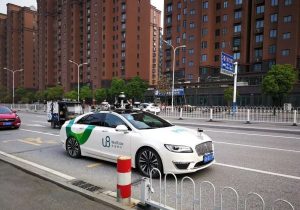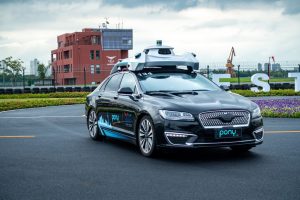When Chinese autonomous driving start-up WeRide conducted a remote driving test using 4G wireless networks two years ago, the results were underwhelming: The top speed reached within safety parameters was only 5 kilometers per hour.
Soon after, WeRide was approached by national telecoms carrier China Unicom with an offer to help it migrate its driverless technology to next-generation 5G networks. Within a month, Unicom had installed more than a dozen 5G base stations on Guangzhou Biological Island where WeRide is based, and the safe driving speed increased to 30 to 40 kilometers per hour.
To be sure, WeRide’s vision of a driverless future is not to move drivers from the front car seat to a remote control room, but 5G’s low latency is a major advantage if on-board systems cannot cope with unexpected road events and remote intervention is needed, Zhang Li, a telecommunications industry veteran and WeRide’s chief operating officer, told the South China Morning Post.
Two years after WeRide’s 4G remote control tests, 5G network construction is picking up pace across China as the world’s second largest economy beefs up its technology infrastructure and digitalization to mitigate the impact of the COVID-19 pandemic.
China Mobile, China Unicom and China Telecom–which together serve 1.6 billion mobile subscribers in the country–built nearly 200,000 5G base stations by the end of March out of an annual target of 500,000, data from China’s Ministry of Industry and Information Technology (MIIT) showed.
Next-generation 5G wireless networks are expected to transform a host of industries including online education, gaming, tele-health, remote working, livestreaming and e-commerce.
WeRide is among a number of Chinese tech companies tapping into 5G’s capabilities in so-called cellular vehicle-to-everything (C-V2X) communications. C-V2X enables the exchange of information between vehicles, pedestrians and roadside communications infrastructure with the primary goals of improving road safety and making traffic flow more efficiently.

Still, what role could 5G play in advancing a driverless future? Interviews with industry experts and analysts portrayed 5G as a supplement to on-car intelligence but not essential to achieving truly autonomous driving.
Vehicles are being equipped with powerful sensors and on-board computing capacity with the ultimate aim of achieving truly driverless operation in all traffic conditions. In China, industry studies have concluded that 5G can reduce the high cost of on-board equipment by shifting some computing power off vehicle.
“5G [in a driving environment] is like street lights,” said Zhang. “It’s good to have them in addition to car lights for safety reasons, but it doesn’t mean one cannot drive without street lights, just like autonomous vehicles are still dependent on on-board intelligence.”
However, 5G and smart road infrastructure can still provide an extra layer of safety for emergency remote control as well as freeing up in-car processors from noncore computing tasks such as downloading maps, according to Zhang.
Weaving 5G into autonomous driving is likely to become a driverless solution with Chinese characteristics, all industry experts and analysts agreed, given the country’s lofty ambitions to dominate in both fields driven by aggressive investment plans.
As China’s artificial intelligence champion and a heavyweight in self-driving cars, Baidu is bullish on C-V2X as a way to usher in a true driverless future, according to Li Zhenyu, general manager of the company’s autonomous driving unit Apollo.
The company has built what it says is the world’s largest testing ground for autonomous driving and C-V2X in Beijing, where it is based. Over the past few months it has also finalized deals with cities including Chongqing, Shanxi province’s Yangquan city, and Anhui province’s Hefei city, to build testing grounds and pilot operation zones for autonomous vehicles.
“Baidu has done extensive experiments [in testing 5G for autonomous cars] on the assumption that it will play a positive role in vehicle-to-road communications and even become instrumental to future development,” said Li. “While 4G can serve the need for infotainment on cars, 5G is needed for a ‘true’ V2X system.”

Xu Gang, managing director and senior partner at Boston Consulting Group, echoed the view that 5G can enable a “better-refined” technical solution to help autonomous vehicles better perceive the environment they are driving in. “On-board intelligence is crucial for self-driving,” he said.
In contrast to China’s 5G enthusiasm and also a growing interest from Europe for communication between vehicles and the environment, mainstream applications in the US still rely on dedicated short-range communication (DSRC) for V2X.
DSRC is a wifi based technology which allows non carrier-based communication between cars, pedestrians and infrastructure within a 1,000 meter radius and with a latency of 30 milliseconds, according to Chicago-based consultancy firm Kearney. In comparison, a carrier-based C-V2X system offers a communication range of over 1,000 meters and latency of less than 4 milliseconds.
As a tech-enabled mobility future unfolds in China and around the world, experts believe a carrier-based C-V2X system could emerge as a unique Chinese approach for autonomous driving over the coming decades. A more immediate use could be in enclosed traffic environments where vehicular routes are predetermined, such as mines, as well as on reserved public roads and even highways where driving is not as complex as in urban areas.

To Baidu’s Li, the development of C-V2X under 5G seems “more feasible” in China because of the challenge of changing the existing US road transport infrastructure. “I have talked to peers in the US. It’s not that they don’t want to but [more likely] they lack favourable conditions,” he said.
“Even [a manufacturer] with 100 years of history doesn’t think they can influence the makeover of traffic lights or even roadside infrastructure.”
The Chinese government is also a major factor when it comes to rolling out national infrastructure. “Governments in the US and Europe are not able to deploy 5G buildout on a national scale,” said Dan Wang, analyst with The Economist Intelligence Unit (EIU).
“China is the best possible candidate among other nations to first bring along a carrier-based smart traffic system as its government has the resources to bring together auto firms, carriers and infrastructure builders,” she said.
Still, even for China, building such a massive infrastructure that includes 5G, and developing a complete C-V2X system, requires significant time and investment efforts.
The Chinese government has never revealed publicly the size of investment needed for building a nationwide 5G network. However, Zhang Yunyong, president of the China Unicom Research Institute, said in an interview with the official Securities Daily in May that 10 million 5G base stations would be needed for complete coverage, which would require about RMB 2 trillion (USD 282.5 billion). “It’s a huge amount for the three carriers,” said Zhang, who is also a member of the Chinese People’s Political Consultative Conference (CPPCC), the country’s top political advisory body.
The MIIT said earlier that its goal was to extend 5G coverage to about 300 cities across China by the end of 2020 but it will take longer before the network is stable enough for implementation of C-V2X, according to experts.
“Nearer-term 5G usage for cars in China are about infotainment instead of driving,” said Wang from EIU.
While the more optimistic outlook sees large-scale adoption of autonomous cars happening by 2030, the industry is still far from reaching a consensus on what the implementation will look like.
The ultimate solution would likely be a combination of direct communication and a 5G carrier-based C-V2X system because achieving ultra-high reliability with a single communication interface would be challenging, according to a peer-reviewed report from the Institute of Electrical and Electronics Engineers (IEEE).
“The automotive industry has become unpredictable these days as it has been undergoing a tremendous transformation,” said Xu. “Autonomous driving in the future may not be entirely a matter of self-driving cars, it could be a comprehensive solution involving C-V2X systems.”
While China’s autonomous driving players are making multiple technology bets to find the best solution, the focus on research and investment into on-board intelligence will remain unchanged, according to industry observers.
Despite promising trial results, WeRide, which has been developing level-4 autonomous driving in both China and the US, does not intend to hand over the steering wheel to cloud-based computers even if data can be transmitted via 5G networks. Level 4 autonomous vehicles are cars that can achieve fully autonomous driving but might require human intervention in some circumstances.
“We are still focused on improving the on-board intelligence of autonomous vehicles,” said Zhang, adding that the company will not cut spending on sensors, on-board cameras and Lidar–the remote sensing technology that measures distances using laser light. Nor will it move core computing capacity related to safe driving onto the cloud because a glitch in the network connection could lead to devastating consequences.
“Single car intelligence and 5G will supplement each other. Together they will form China’s own autonomous driving solution,” he said.
This article was originally published in the South China Morning Post.
